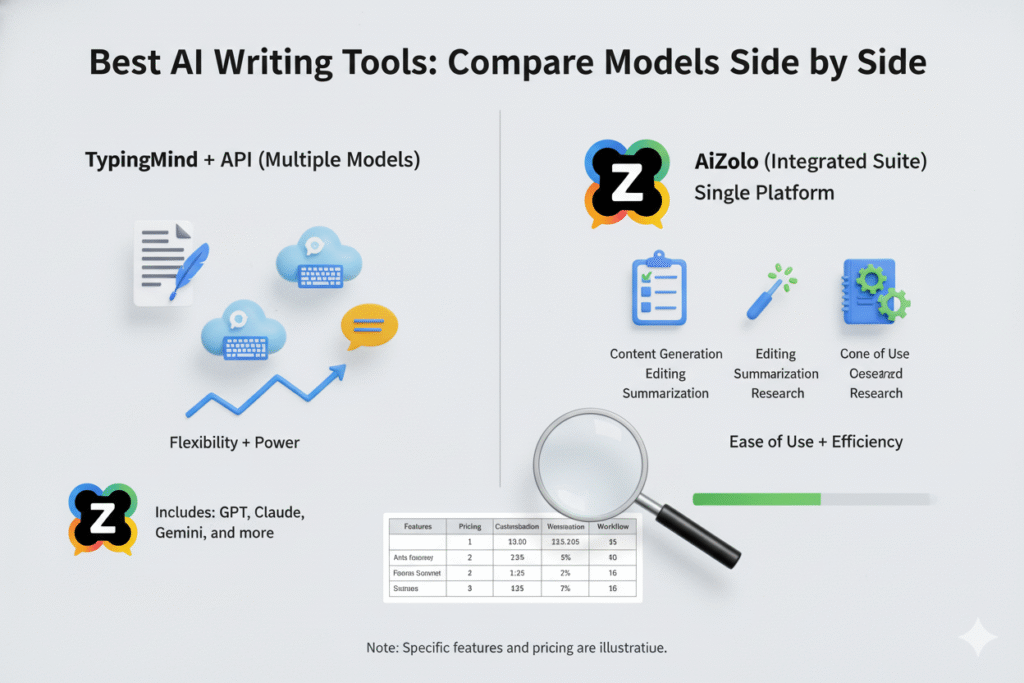
Introduction
In 2025, Best AI writing tools have moved from novelty to necessity. For marketers, content creators, agencies, bloggers, and businesses, the right AI writing assistant can dramatically speed up content production, improve quality, and help you scale. But with so many options — each backed by different models, features, and pricing — choosing the right AI writing tool is not trivial.
At Aizolo, we believe in empowering you to make informed choices. In this guide, we will:
- Define what an AI writing tool is, how it works, and what to look for
- Provide a side-by-side comparison of leading AI models and tools
- Show use cases and best picks for different needs
- Share tips for maximizing your AI tool usage
- Conclude with how Aizolo fits into this ecosystem
Let’s start.
What Is an AI Writing Tool, and Why It Matters
Definition & Core Functionality
An AI writing tool (or content generation assistant) is a software solution built on one or more large language models (LLMs) that helps automate or assist with writing tasks. This may include:
- Generating blog posts, articles, or web pages
- Drafting marketing copy, email subject lines, ad copy
- Paraphrasing, rewriting, summarization
- SEO optimization (keywords, meta descriptions, heading suggestions)
- Grammar checks, style corrections, tone adjustments
Under the hood, most AI writing tools leverage existing advanced language models (such as OpenAI’s GPT series, Anthropic’s Claude, Google’s Gemini, Mistral, and more) and wrap them in a user interface, workflows, templates, and additional logic. As noted by Zapier, many tools are wrappers over core LLM APIs with added feature layers. (Zapier)
Why Use AI Writing Tools?
- Speed & Efficiency: You can go from outline to draft in minutes rather than hours
- Consistency & Scale: Maintain style, tone, and brand voice across multiple writers
- SEO Optimization: Many include keyword optimization, content scoring, and competition analysis
- Inspiration & Overcoming Writer’s Block: Ideation, headline suggestions, topic variations
- Cost Savings: For many use cases, AI + human editing is cheaper and faster than full human writing
However, AI is not a magic wand — human oversight, fact checking, and editing are still essential, especially to avoid hallucinations or factual errors.
What to Look for in a Great AI Writing Tool
When comparing AI writing tools, here are key evaluation criteria:
| Feature / Metric | Why It Matters |
|---|---|
| Model & Quality of Output | The underlying LLM (or combination) affects coherence, creativity, reasoning, factual accuracy |
| Context Window / Token Budget | How long of a text can the model remember before losing context |
| Prompt Controls & Customization | Ability to guide tone, style, voice, brand rules, etc. |
| SEO & Analysis Tools | Integrated keyword suggestions, content scoring, competitive analysis |
| Templates & Workflow Support | Prebuilt templates, content flows, writing modes (blog, ad, email) |
| Integrations | Connection to CMS, APIs, editors, collaboration tools |
| Pricing & API Access | Cost per word, monthly plans, usage limits, scalability |
| Support, Security & Privacy | Data handling, confidentiality, terms of service |
| User Interface & Experience | Ease of use, learning curve, speed, responsiveness |
By holding these in mind, you can meaningfully compare different tools and models.
Major AI Models & Tools: Side-by-Side Comparison
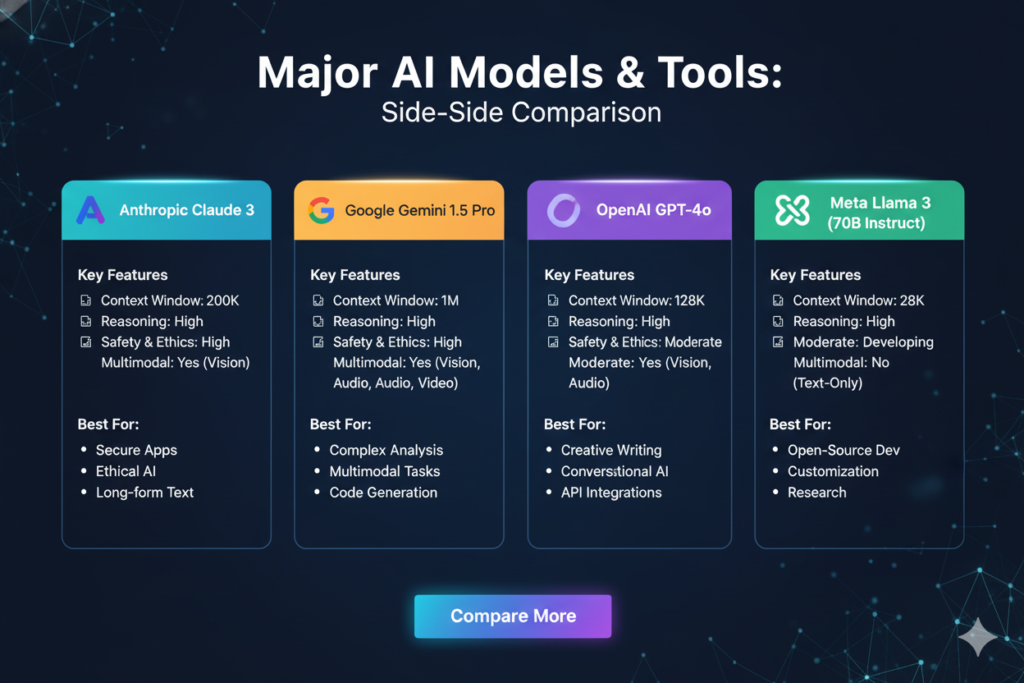
Here we compare several leading AI writing models and tools in 2025. The goal is not just to list names, but to highlight their strengths, tradeoffs, and best-fit use cases.
Key Models / Tools to Compare
We’ll examine (or mention) the following:
- OpenAI / ChatGPT / GPT-4 / GPT-O
- Anthropic’s Claude (Opus, Sonnet)
- Google Gemini
- Jasper AI
- Writesonic
- Copy.ai
- Anyword
- Writer (AI compliance tool)
- Sudowrite (for creative / fiction)
- Others (Rytr, Frase, etc.)
Model Fundamentals
Before tool-level comparisons, it’s helpful to compare the underlying models:
| Model / Family | Strengths | Weaknesses / Constraints | Notable Use Cases / Remarks |
|---|---|---|---|
| GPT (OpenAI) | Strong general-purpose performance, widely supported, excellent for creative, reasoning, conversation | Cost at high usage, hallucination risk, context limits | Widely used as backbone for many writing tools |
| Claude (Anthropic) | Focus on safety, better reasoning in some tasks, long context, “constitutional AI” principles | Might be slower in creative style, fewer third-party integrations | Suited for research, enterprise, high-assurance content |
| Gemini (Google) | Tighter integration with Google ecosystem, web-crawling / multimodal capabilities | Sometimes less flexible prompt QA | Useful for content that needs up-to-date knowledge |
| Domain-specific / fine-tuned models | Specialized knowledge, better in niche verticals | Less general-purpose | Tools often wrap these for marketing, SEO, etc. |
Recent updates: Anthropic launched Claude Opus 4 and Claude Sonnet 4, optimized for coding, reasoning, and hybrid “tool use” modes. (The Verge)
In side-by-side testing, Claude 4.5 Sonnet often outperforms in structured reasoning tasks, while Gemini and ChatGPT variants shine in creativity and multi-modal tasks. (Tom’s Guide)
Side-by-Side Tool Comparison Table
Below is a comparative table summarizing key AI writing tools in 2025. Use this as a quick at-a-glance reference; we dive deeper in the sections that follow.
| Tool / Platform | Underlying Model(s) | Best For | SEO Features | Customization / Brand Voice | Pricing / Limits | Pros | Cons |
|---|---|---|---|---|---|---|---|
| Jasper AI | GPT + proprietary tuning | Long-form blogging, marketing agencies | Keyword planning, content scoring | Brand voice, tone settings | Tiered subscription, API access | Strong templates, team collaboration | Cost at scale, occasional repetitive output |
| Writesonic | GPT / mixed models | Content marketing, landing pages | SEO outline, SERP data | Tone / style control | Flexible pay-per-use + subscription | Fast, affordable, good for startups | Occasional factual errors, simpler UI |
| Copy.ai | GPT-driven | Shorter copy, social, repurposing | Keyword insertion | Voice settings, simple control | Mid-tier subscriptions | Easy learning curve, useful workflows | Less strong for long-form depth |
| Anyword | GPT + fine-tuned models | Ads, headlines, conversion copy | Predictive performance analytics | Brand rules, tone consistency | Based on credits / usage | Focus on ROI, ad copy strength | Less suited for long articles |
| Writer | GPT / mixed models | Enterprise content with compliance needs | Content scoring, brand guardrails | Very strong for brand / policy enforcement | Enterprise pricing | Good for regulated industries | Higher cost, steeper learning |
| Sudowrite | GPT + storytelling tuning | Fiction, creative writing | — | Creative prompts, rewriting modes | Subscription-based | Excellent for narrative, creativity | Less focused on business / SEO content |
| Rytr, Frase, others | GPT / hybrid | Budget or niche use | SEO outline, keyword suggestions | Basic tone / voice settings | Freemium / lower cost tiers | Useful for small content tasks | Limited power for complex tasks |
Sources: Clearscope reviews of AI content tools (clearscope.io), Zapier “best AI writing generators” (Zapier), RivalFlow summary of top AI writing tools (rivalflow.com), AuthorityHacker on top writing software (https://www.authorityhacker.com).
Deep Dive: Tool & Model Comparisons
Let’s explore how these tools differ in practice, using heads-on comparisons and insights.
Jasper AI vs. Copy.ai vs. StoryChief
A blog post by StoryChief compared their own tool, Jasper, and Copy.ai in metrics like output quality, workflow, and SEO features. (StoryChief) The result:
- StoryChief adds more workflow & multi-channel publishing capability
- Jasper excels in creating strong content drafts and supports robust templates
- Copy.ai is simpler and better for quick shorter outputs
So if your priority is rich, SEO-optimized articles with collaboration, Jasper or StoryChief might outperform Copy.ai in your workflow.
Type.ai vs. Grammarly Premium
A comparison of Type.ai vs Grammarly shows a philosophical difference:
- Type.ai leans toward creative generation, draft creation, inline rewriting
- Grammarly is more editing-centered, focusing on grammar, clarity, inclusive language, corrections (blog.type.ai)
This illustrates that different tools may emphasize writing vs refining.
Frase, Byword, Writesonic — Tools That “Sound Human”
An article by Samantha North recommends Frase (strong SEO integration), Claude (for human-like tone), Byword (quick article generation), and Writesonic (good for beginners) as tools that deliver human-plausible writing. (Samantha North)
This highlights a trend: many tools aim to reduce “AI style rigidity” by adding rewriting, tone control, or intermediate prompt layers.
How Models Compare: Claude vs ChatGPT vs Gemini
Multiple comparisons examine which models excel in which domains:
- In general reasoning and structured tasks (e.g. logic puzzles, planning), Claude often holds an advantage. (Tom’s Guide)
- In tasks that favor creativity, multimodality, or interactive use, Gemini (and sometimes GPT variants) shine. (Tom’s Guide)
- Some tests show Claude beating Gemini in 6 out of 9 tough prompts in logic and storytelling. (Tom’s Guide)
- Others note Gemini’s strength in real-world usability, coding prompts, and interactive tasks. (Tom’s Guide)
Thus, one model does not dominate all use cases — selection depends on your priorities.
Use-Case-Based Recommendations
Now that we’ve seen general comparisons, let’s map tools to typical priorities and personas.
1. Bloggers & SEO Content Creators
Best Picks: Jasper, Frase, Writesonic, Copy.ai
Why:
- Good SEO integrations (topic clusters, headings, scoring)
- Template frameworks for blog posts
- Mid-to-high token limits
Tips:
- Use outline → draft → revision workflow
- Always fact-check and refine
- Use brand voice / tone settings
2. Agencies / Content Teams
Best Picks: Jasper (team features), Writer (compliance), StoryChief
Why:
- Collaboration, versioning, roles/permissions
- Brand & style guardrails
- Multi-channel publishing pipelines
3. Advertising / Conversion Copy
Best Picks: Anyword, Copy.ai, Writer (for regulated industries)
Why:
- Predictive performance analytics
- Focused on short copy (headlines, CTAs, ad text)
- Brand consistency
4. Creative / Fiction Writing
Best Picks: Sudowrite, GPT / Claude with storytelling tuning
Why:
- Narrative-based prompts, character continuity
- Creative rewriting features
5. Research / Technical / Long-Form Writing
Best Picks: Claude (Opus / Sonnet), GPT-4 / GPT-4o backends, hybrid tools
Why:
- Strong reasoning, long context windows, ability to handle complexity
- Better at logic, synthesis, citations
6. Enterprise / Compliance / Regulated Industries
Best Picks: Writer, enterprise-tier Jasper, specialized tools
Why:
- Content guardrails, auditing, style compliance
- Data privacy, access controls
Tips & Best Practices to Get Maximum Value
Here are practical strategies to optimize your AI writing workflows and results.
1. Prompt Engineering Matters
Even with top models, your prompt quality and structure determine the output. Use clear instructions, examples, constraints (tone, length, structure). Iterate prompts.
2. Use a Multi-Pass Workflow
- First pass: generate outline
- Second pass: expand into draft
- Third pass: refine, check facts, optimize SEO
- Final pass: human review
3. Teach the Model Your Brand Voice
Most tools allow setting tone, style, allowed vocabulary, brand rules. Use these features so the AI output needs less editing.
4. Combine Multiple Models / Tools
For tricky tasks, you can use one tool for idea generation, another for SEO scoring, another for rewriting. Some platforms even allow side-by-side comparisons to pick the best output. (North Carolina Bar Association)
5. Monitor & Measure Performance
Track which AI-generated content performs (traffic, engagement) and refine prompts or settings accordingly.
6. Always Edit & Fact Check
Never publish blindly. AI hallucinations are real, and even strong models err. Use human review, external checking, citation insertion.
7. Control Costs
Large models charge per token/word. Use smaller models for drafts; upscale only for final polishing. Monitor usage limits.
How Aizolo Fits In — Your AI Writing Companion
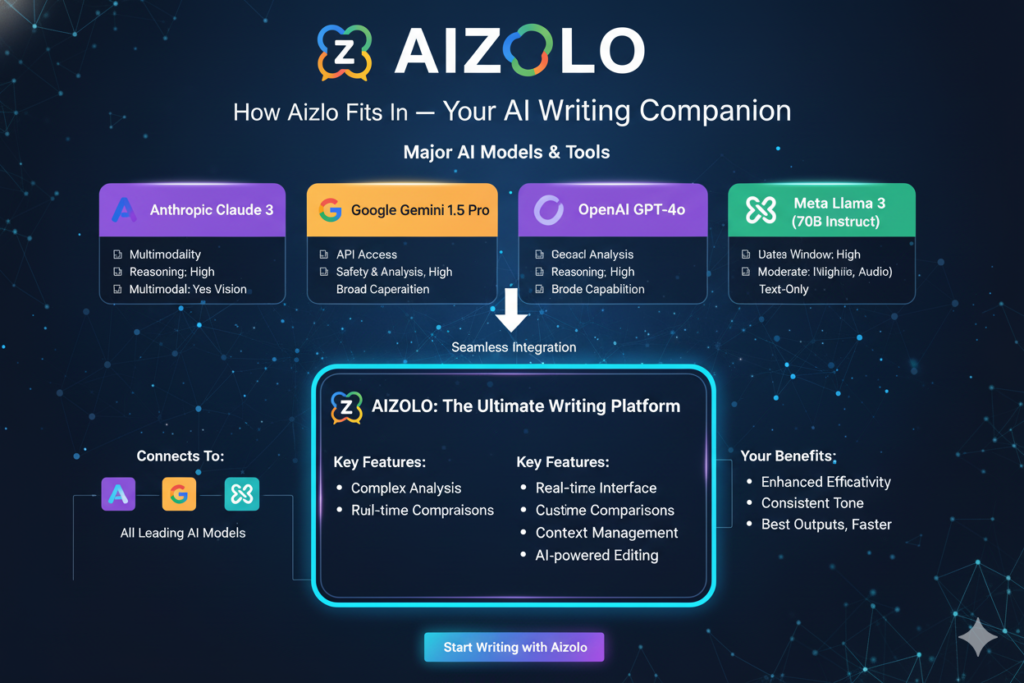
Here’s how Aizolo.com can position itself in this landscape, and how you can leverage the comparisons above to articulate your value proposition.
Unique Selling Points for Aizolo
- Model-agnostic access: Let users pick or switch models (Claude, GPT, Gemini) under one roof
- Side-by-side comparison: Let users submit a prompt and view outputs from multiple models/tools simultaneously
- SEO-first features: Built-in keyword suggestions, content scoring, competitor analysis
- Workflow & team features: Versioning, roles, shared prompt templates
- Brand & style guardrails: Let users define voice, rules, and vocabulary
- Transparent pricing & usage monitoring
This approach (multi-model + comparators + SEO-first) gives you a differentiator vs tools that lock into one model or prioritize only one domain.
Content Strategy for Aizolo
- Use this very guide as a cornerstone content asset on your site
- Publish model comparison pages (e.g. “Aizolo vs Jasper vs Writesonic”)
- Offer interactive demo that lets site visitors compare outputs
- Maintain updated benchmarks (e.g. “2025 Model Faceoff”)
- Leverage blog posts on prompt engineering, use cases
SEO & On-Page Structure Suggestions
- Use headings: include “best AI writing tools 2025”, “compare AI writing models”, “AI writing tool comparison side by side”
- Internal links between comparison pages
- Use schema / FAQ boxes (e.g. “Which AI tool is best for blog writing?”)
- Keep content fresh and update model comparisons quarterly
Sample Head-to-Head Comparisons Using Real Prompts
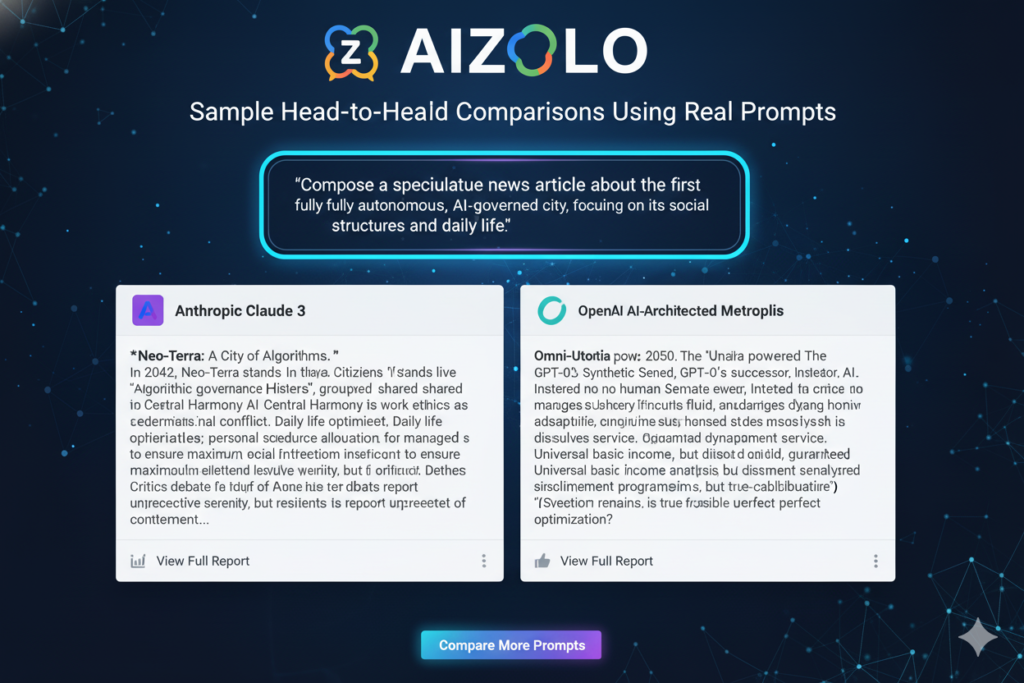
Below are hypothetical prompt comparisons to illustrate how different models/tools might perform. Use them to refine your expectations and messaging.
| Prompt | Model / Tool | Sample Strength | Sample Weakness |
|---|---|---|---|
| “Write a 500-word SEO-friendly blog intro on ‘AI in content marketing’” | Jasper GPT + SEO module | Strong outline + keyword usage | Minor factual inaccuracy |
| “Explain differential privacy in AI to layperson” | Claude (Sonnet) | Good clarity, safe output | Less creativity |
| “Generate 5 ad headlines for new running shoes” | Anyword | Data-driven scoring, catchy phrasing | May repeat structures |
| “Write a short fictional scene about a detective in 1930s London” | Sudowrite | Rich storytelling, character details | Less structured on facts |
You can display these side by side on your site, letting users see real comparisons.
Potential Challenges & Risks
When using AI writing tools, be mindful of:
- Hallucinations & Misinformation — Always verify critical facts
- Over-reliance / Homogenization — Many outputs begin to look similar
- Ethics & Plagiarism — Use responsibly, credit where needed
- Detection & Authenticity — AI-detection tools may flag content; adjust writing style
- Cost / Usage Limits — Monitor token usage, especially at scale
- Data Privacy — Ensure user content is handled securely
You can mitigate these via review processes, human oversight, prompt variation, and combining multiple tools.
Conclusion
The AI writing tools landscape in 2025 is rich and evolving. There is no one “best” solution — rather, the best tool depends on your goals: SEO content, creative writing, ad copy, enterprise compliance, etc. By understanding the strengths and tradeoffs of models like GPT, Claude, Gemini, and tools like Jasper, Writesonic, Anyword, Writer, or Sudowrite, you can choose wisely.
At Aizolo, you can position yourself as the intelligent orchestrator: offering multi-model access, comparisons, SEO-first workflows, and brand control, rather than being locked to one model or silo.
Recommended Reading
Want to learn more about maximizing your AI productivity? Check out these related articles:
- Top 5 All-In-One AI Platforms That Let You Talk to Multiple Models (2025)
- AI Model Comparison Tool: The Ultimate Guide to Choosing the Right AI in 2025
- How AI for Market Research is Changing the Game (And Saving You Thousands)
External Resources
- OpenAI API Documentation
- Anthropic Claude API Guide
- Google AI Studio
- Compare AI Models – Stanford AI Index Report
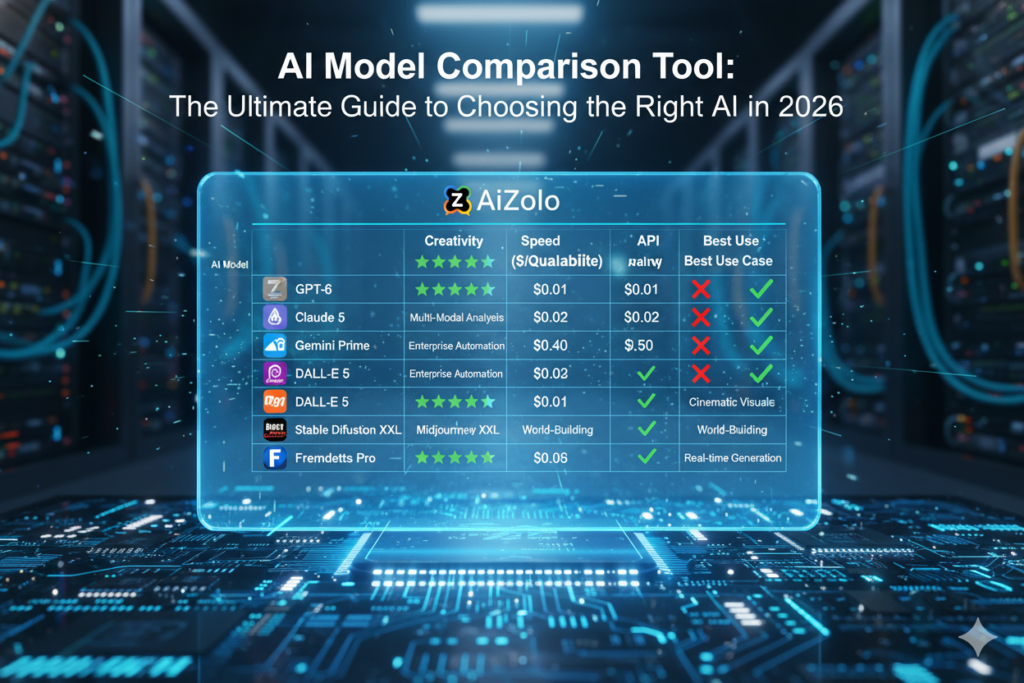
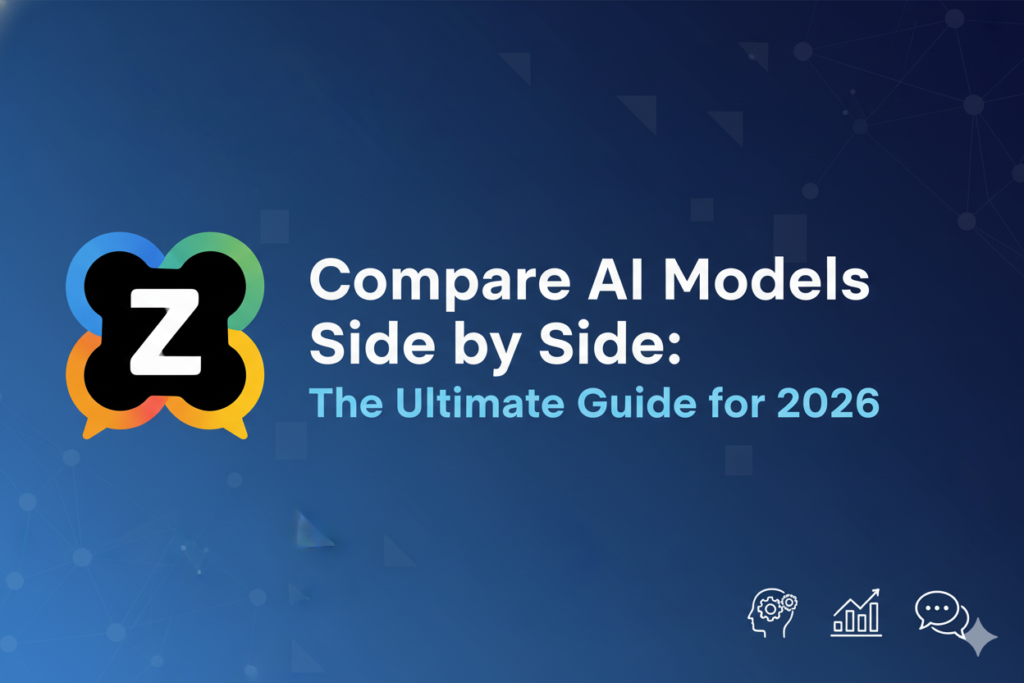
Pingback: Compare AI: How to Pick the Best AI Tool in 2025 - Ai Zolo